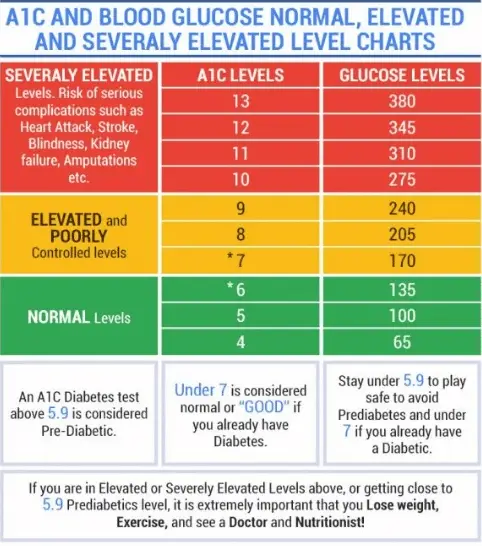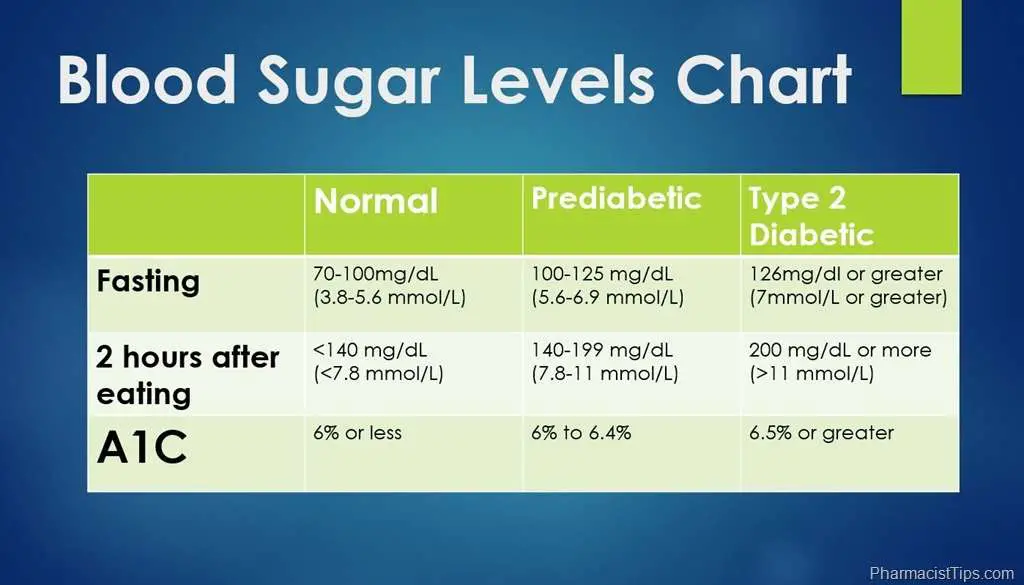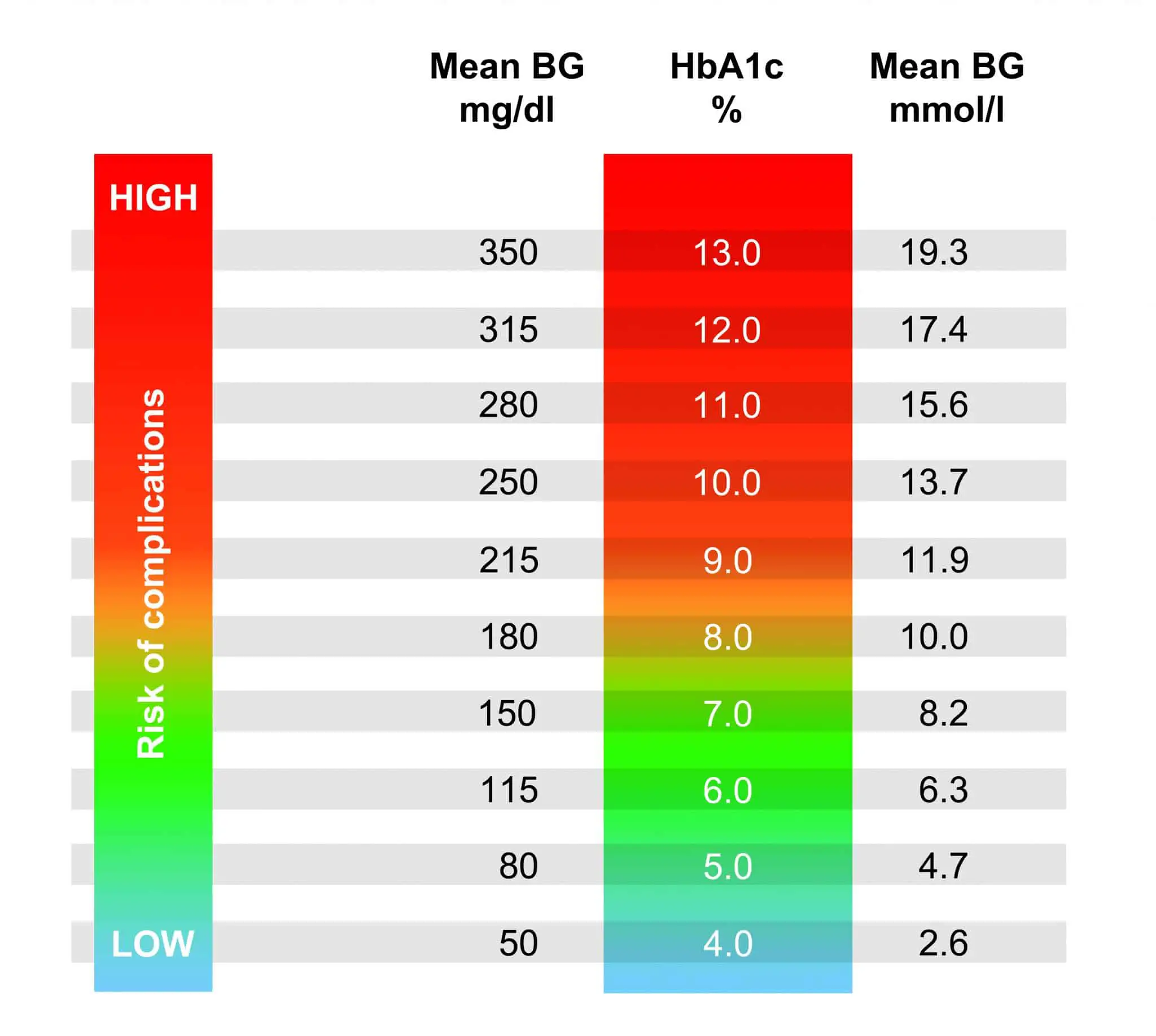Normal Blood Sugar Levels For Nondiabetic Adults
A preprandial blood sugar measurement is one taken before meal. It is measured after fasting for at least 8 hours , hence also referred to as fasting blood sugar.
According to the American Diabetes Association , a normal fasting blood sugar for a non-pregnant adult is from 70 to100 mg/dL . If we assume a normal fasting blood sugar of an average healthy adult without diabetes is around 80 mg/dL , that gives us less than one teaspoonful of sugar in the whole blood volume of an average person.
Low Blood Sugar Symptoms
Hypoglycemia happens when blood glucose levels drop too low. Low blood sugar can be caused by many things including the two different types of diabetes, certain medications, alcohol, endocrine disorders, eating disorders, pregnancy , and disorders of the liver, kidneys, or heart.
Here are some of the most common symptoms that someone with low blood sugar might experience:
- Lightheadedness
If your blood sugar is low you might start to feel some of the first signs of hypoglycemia like dizziness, lightheadedness, or sweating. The only way to know for sure if your blood sugar is low is to test it with a glucose meter or other glucose monitoring device.
If you dont have access to these tools and start to feel the symptoms of low blood sugar, consume 15 grams of carbs or take a quick dissolve glucose tablet to raise your blood sugar levels and avoid further symptoms, according to the American Diabetes Association . Once your blood sugar is back in its target range, you can have a snack or meal to make sure it doesnt drop again.
Here are some other lifestyle and medicinal treatments that can help treat hypoglycemia:
- Eat a healthy diet full of whole foods that are minimally processed.
- Take prediabetes or diabetes medications as recommended by your healthcare provider.
- Use a glucagon kit in emergencies. Glucagon is a hormone that raises blood sugar levels quickly.
Random Blood Sugar Test
This measures your blood sugar at the time youre tested. You can take this test at any time and dont need to fast first. A blood sugar level of 200 mg/dL or higher indicates you have diabetes.
Random Blood Sugar Test| 140 mg/dL or below | N/A |
*Results for gestational diabetes can differ. Ask your health care provider what your results mean if youre being tested for gestational diabetes.Source: American Diabetes Association
If your doctor thinks you have type 1 diabetes, your blood may also tested for autoantibodies that are often present in type 1 diabetes but not in type 2 diabetes. You may have your urine tested for ketones , which also indicate type 1 diabetes instead of type 2 diabetes.
You May Like: Should I Do Intermittent Fasting
Target Blood Sugar Levels In Children With Diabetes
Children younger than 6 years old Blood sugar in mg/dL Bedtime 110-200
Children under 6 years of age should have blood glucose levels that range from about 80 to 200 mg/dL each day. This range is considered healthy, and the amount of glucose in a childs body will fluctuate from the time they wake up to after theyve eaten meals and again before bedtime. For this reason, kids with diabetes or hypoglycemic episodes may have to have their blood sugar levels tested in the middle of the night by their parents. Many children with type 1 diabetes wear a continuous glucose monitor , which displays glucose levels all the time and mostly eliminates the need for finger sticks.
Normal Blood Sugar Levels In Children With Diabetes According To Age

Summary
Read Also: Can You Have Coffee In Intermittent Fasting
If You Have An Acute Illness
Acute illnesses such as infections can affect your ability to control diabetes and can lead to serious diabetic complications, such as ketoacidosis, hyperosmolar coma and severe dehydration. Your health care provider will give you instructions about how to care for diabetes during acute illnesses, and you can learn to avoid acute complications through patient education.
Still Frustrated With Your Blood Sugar And A1c Results
Your blood sugars and your insulin or medication needs never stay in one place. If you gain weight or lose weight, your insulin and medication needs will change. If you become more active or less active, your needs will change. If you make drastic or even small changes to your nutrition, your needs will change!
Working with your diabetes healthcare team, and diabetes coaches who can teach you how to make changes in your overall diabetes management plan are essential. Diabetes is a lifelong learning process.
Take a deep breath and be patient. If you dont like what youre seeing on your glucose meter, dont get madget studying! Take good notes and work with your team to make changes to reach your goals.
Read more about improving your A1c in DiabetesStrongs guide, How to Lower Your A1c.
If you liked this guide to normal blood sugar levels, please sign up for our newsletter using the form below. We send out a weekly newsletter with the latest posts and recipes from Diabetes Strong.
Read Also: Alternate Day Fasting Results 1 Month Female
What Is Considered A Normal Blood Sugar Level
The normal blood sugar level for a healthy adult should be less than 126 mg/dL or 6 mmol/L before fasting and meals, and below 200mg/dL two hours after meals.
If you are diabetic, then you should consult with your doctor in order for appropriate blood sugar level targets to be set based on the severity of your condition, medications taken and overall health status.
The below information describes what normal blood sugar levels are prior to and after meals and what the recommended HbA1c levels are for those with and without diabetes.
A HbA1c test determines your average level of blood glucose over the past two to three months. Red blood cells have a lifespan of roughly three months, and a HbA1c blood test measures the amount of glucose that has bound to them during this period.
A blood test to determine Haemoglobin A1c levels is often performed in those who have diabetes. These levels are a reflection of how well diabetes is being controlled.
Donât Miss: How Much Can You Lose On Intermittent Fasting
What Is Low Blood Sugar
Hypoglycaemia is a condition wherein blood sugar levels are too low. This condition affects a number of diabetic people when their bodies do not have enough glucose to use as energy. Hypoglycaemia is commonly the result of taking too much of the medication/s prescribed to treat diabetes, eating less than expected, exercising more than normal or skipping meals.
Some of the symptoms of hypoglycaemia include:
Recommended Reading: Does Intermittent Fasting Slow Metabolism
Prime Full Body Check Up
Offer Price:
| Before bedtime | 100-140 |
If you get a routine blood test done and the levels are low or high from the normal range, it indicated risks of diabetes or hypoglycemia. These instances require immediate medical interventions, especially if you dont want to get undiagnosed for a serious chronic illness.
Symptoms Of Low Sugar Level
Low blood sugar condition or Hypoglycemia occurs when blood glucose levels fall below 70 mg/DL.
Fluctuation in blood sugar levels may be due to the following factors:
It is possible to eliminate these symptoms with the right guidance from certified diabetes reversal coaches who understand your routine and current lifestyle and help you with diet and lifestyle changes that can be easily done by you. These small changes lead to a drastic impact on your blood sugar levels and help you reverse your diabetes.
Also Read: Indian Diet Chart for Diabetic Patients
Read Also: Best Intermittent Fasting For Menopause Belly
Official Hba1c Ada Recommendation For Someone With Diabetes
The American Diabetes Association recommends an HbA1C of less than 7% for most nonpregnant adults with diabetes. A lower goal, such as less than 6.5%, may be appropriate for some people who have had diabetes for a shorter amount of time, for younger people, for those without heart disease, and/or for those with type 2 diabetes treated with lifestyle or metformin only. A higher HbA1C goal, such as less than 8%, may be appropriate for people with a history of severe hypoglycemia, a limited life expectancy, advanced diabetes complications, other illnesses, or for whom a lower HbA1C goal is difficult to achieve. Its important that people with diabetes discuss their target blood sugar goals with their health care provider.
HbA1C levels should be checked between two to four times per year in people who have diabetes.
Symptoms Of High Sugar Level

When blood sugar levels are high above the normal > 180mg/dL, it can be again dangerous and requires medical attention. This condition, also known as hyperglycemia, occurs when the body has insulin deficiency or cannot use it properly.
Some of the common symptoms of high blood sugar levels are:
If left untreated, hyperglycemia can lead to diabetic ketoacidosis, which is a life-threatening disease. Moreover, it can also cause heart complications, kidney-related problems, and liver disorders.
Also Read: Triglyceride Level Chart For Adults
You May Like: How To Maximize Weight Loss With Intermittent Fasting
Results Reporting Critical Findings
Normal plasma glucose levels are defined as under 100 mg/dL during fasting and less than 140 mg/dL 2-hours postprandial. Additionally, glucose levels in healthy individuals can vary with age. Fasting plasma glucose in adults tend to increase with age starting in the third decade of life but does not increase significantly beyond 60 years of age. Normal HbA1c is lower than 5.7%.
Diagnosis of diabetes depends on plasma glucose, which is measurable during fasting, the oral glucose tolerance test or using the A1c criteria. Fasting plasma glucose measurements show glucose levels at the point in time whereas HbA1c measures the average amount of glycation to hemoglobin, usually accumulating over 2 to 3 months. According to the American Diabetes Association , fasting plasma glucose greater than or equal to 126 mg/dL is diagnostic. Confirmation of the diagnosis requires two abnormal test results conducted from the same sample or two separate samples. Other equivalent diagnostic criteria include 2-hour plasma glucose of greater than or equal to 200 mg/dL during OGTT or A1c of greater than or equal to 6.5% . Clinically, a patient with symptoms of hyperglycemic crisis and random glucose of greater than or equal to 200 mg/dL also meet the diagnostic criteria.
Normal Blood Sugar Levels
It is important to work with your doctor to maintain healthy blood sugar levels. The following is a list of healthy blood sugar levels.
If an individual has type 1 diabetes the blood sugar should be the following:
- Before meals: From 90 to 130 mg/dL for adults
- After meals : Less than 180 mg/dL for adults
- At bedtime: From 90 to 150 mg/dL for adults
If an individual has type 2 diabetes, levels should be the following:
- Before meals: From 70 to 130 mg/dL for adults
- After meals : Less than 180 mg/dL for adults
Donât Miss: How Many Hours For Intermittent Fasting
Read Also: What Can I Eat During Fasting In Intermittent Fasting
Is There Anything Else I Should Know About A Blood Glucose Test
If you have diabetes, you may need to do blood sugar testing at home every day to help manage your blood glucose levels. There are two ways to do this:
- Blood glucose meters require you to prick your finger with a small device called a lancet. You apply a drop of blood to a test strip and insert it into a small, electronic glucose meter, which measures the glucose is in your blood.
- Continuous glucose monitors use a tiny sensor that you insert under your skin. Every few minutes, the sensor measures glucose levels in fluids between your cells. If your glucose is too high or too low, you use a blood glucose meter to check your blood levels before making changes to raise or lower your glucose level.
Alternative Explanations For The Rise In My Fasting Blood Glucose
Is it possible that the three fasting blood glucose levels were high despite me being normoglycemic ?
I can think of two realistic conditions that would have led to this situation:
Although laboratory error is something to consider, I dont think this is a viable explanation. I am confident the laboratory performs the fasting blood glucose test with high reliability and precision.
Recommended Reading: What Should I Eat When Intermittent Fasting
Causes Of High Blood Glucose
- The hormone, insulin, regulates blood glucose levels by stimulating various tissues to take up glucose from the blood. In this way it clears the blood of excess glucose. A deficiency or resistance of the bodys cell to insulin is one the main reasons for hyperglycemia.
- Certain drugs may produce hyperglycemia . Some examples of these hyperglycemia inducing drugs include corticosteroids, beta blockers, thiazide diuretics, niacin, protease inhibitors, amphetamine, olanzapine, duloxetine.
- Other than diabetes, conditions such as acute stress, myocardial infarction , stroke, pancreatic diseases, brain tumors and hormonal dysfunctions of adrenal, pituitary, and thyroid glands could also cause hyper-glycemia.
Dont Miss: Should You Fast For An A1c Blood Test
What Is Blood Glucose Anyway
Blood glucose, or sugar, is sugar that is in your blood . It comes from the food that you eat foods that contain carbohydrate, such as bread, pasta, and fruit are the main contributors to blood glucose. The cells in our bodies need glucose for energy and we all need energy to move, think, learn, and breathe. The brain, which is the command center, uses about half of all the energy from glucose in the body.
Read Also: When Do You Eat On Intermittent Fasting
Causes And Symptoms Of Diabetes
The values of blood glucose that are slightly higher than the normal values indicate higher risk of developing diabetes. This condition is known as prediabetes. Regular check ups help diagnose diabetes in early stage which helps control the disease with the help of modified diet, exercise, and medications. Frequent urination, increased wound healing time, increased thirst, strong hunger prangs, blurry vision, frequent infections, weight loss, excessive weakness, and changes in skin are some symptoms of diabetes. Obesity, high blood pressure, family history, insulin resistance, low insulin levels, high cholesterol and/or triglycerides levels, and lack of exercise are some of the common factors which can lead to diabetes.
Language Matters In Diabetes

Words make a difference when youre talking about diabetes. Thats especially true in the context of blood sugar levels and how someone manages their health.
Here are some suggestions on language choices when talking with someone about their blood sugars and glucose levels.
- Try to avoid using terms like good or bad for higher or lower blood sugars.
- Instead, try to not tie value judgments to these numbers. Think about them as just numbers, in range or not, and pieces of data to help make a decision in diabetes care. Sometimes glucose numbers are too low or too high, and its helpful for the person with diabetes to understand why those glucose fluctuations are happening.
Read Also: How Long Should Intermittent Fasting Be Done
How To Maintain Normal Blood Glucose Levels
If you arent at risk of developing diabetes due to genetic predisposition, maintaining normal blood glucose levels is fairly easy.
All you have to do is be mindful of your lifestyle choices and dietary habits.
Some of the effective tips and precautionary insights include:
- Instead of eating refined foods, switch to whole-grain foods high in fiber and have a low glycemic index.
- Indulge in regular exercising as per your health and well-being. Even a morning or evening walk is considered good for your well-being if you lead a sedentary lifestyle.
- Unless instructed otherwise by your doctor due to other health complications, ensure that you drink enough water throughout the day. Hydration is key to regulating your blood glucose levels.
- If you are on medications for diabetes or on insulin, discuss changing or adjusting the dosage as per your current blood glucose levels.
